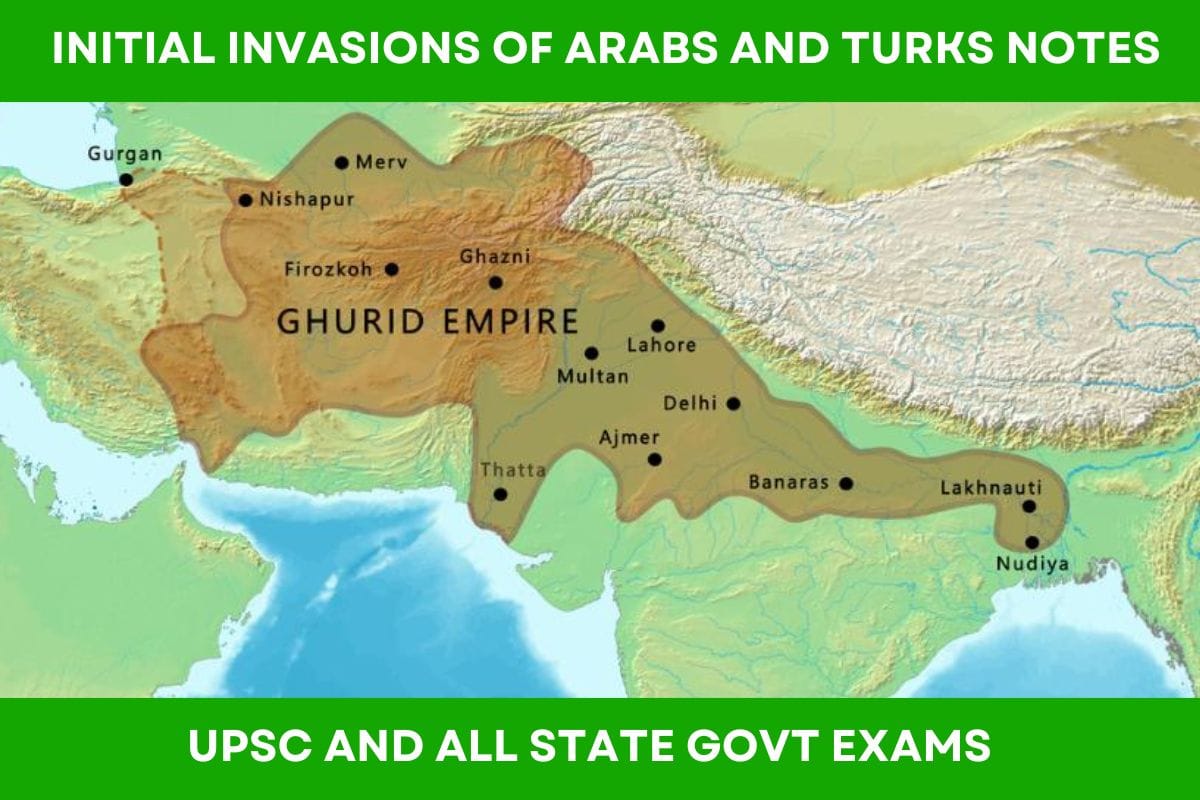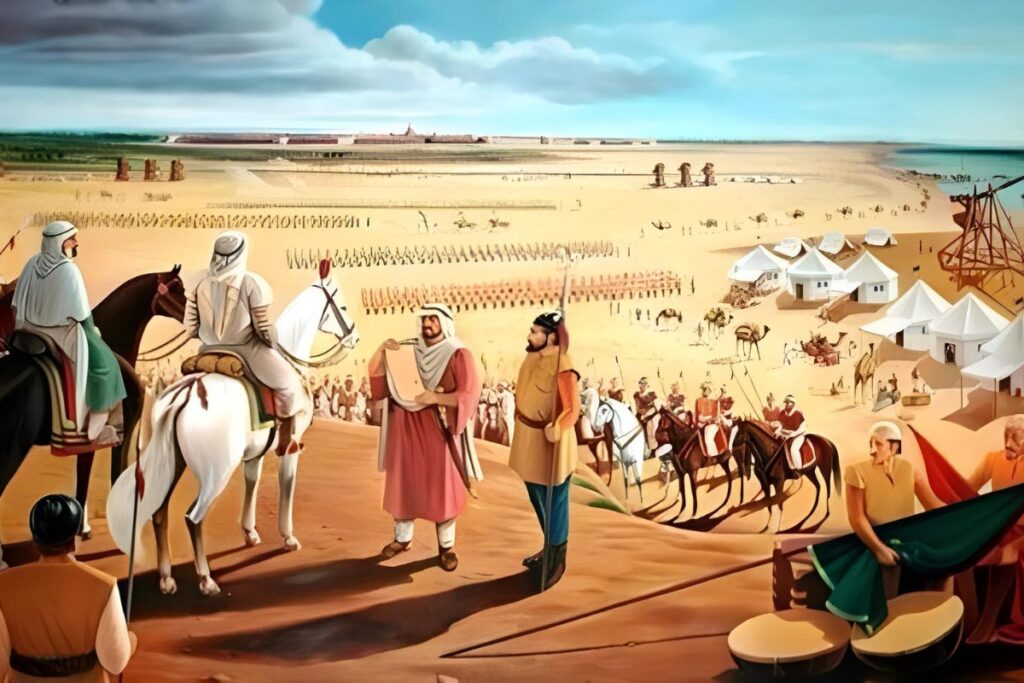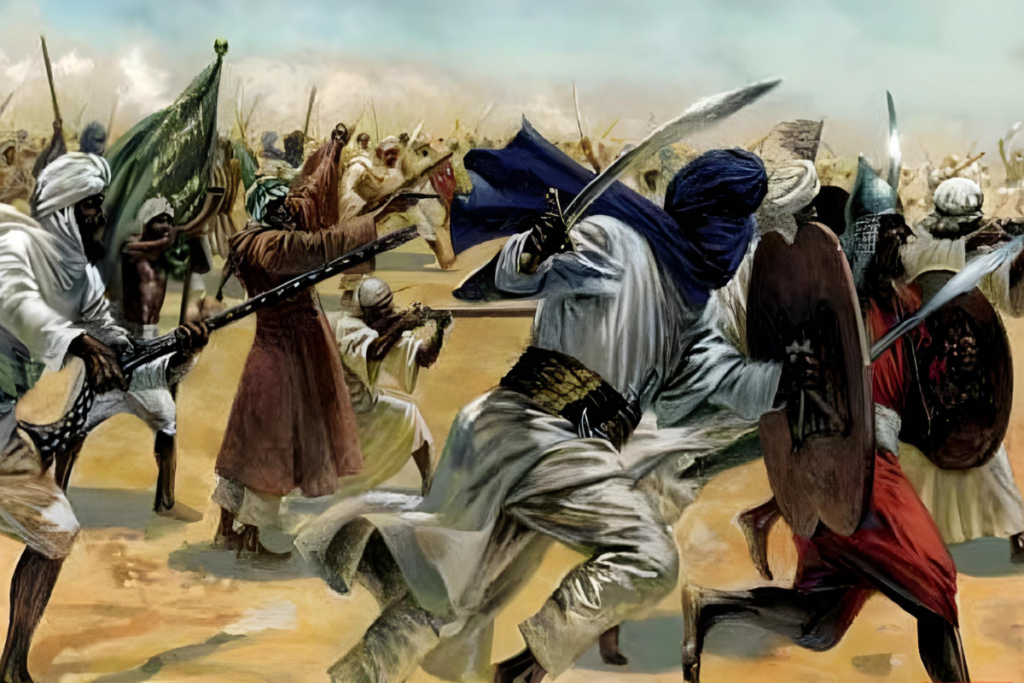
The Arab and Turkish invasions stand as a pivotal subject, altering the trajectory of history.
The commencement of Arab and Turk incursions into India initiated when the Arab forces, led by Mohammed Bin Qasim, invaded the northwestern region in 712 CE. Having established prosperous trade ties with India, the Arabs were well-acquainted with the nation’s abundant resources and immense wealth.
This awareness fueled their interest in expanding their influence in India, encompassing both territorial gains and the propagation of the Islamic faith.
The period from 1000 to 1000 CE witnessed significant transformations in Central Asia and Northern India. Mahmud Ghaznavi, the inaugural Turkish sovereign to venture into India, targeted regions dominated by the Rajputs. His motivation was not to govern India but to extend his realm into Iran, Afghanistan, and Khorasan.
The primary impetus behind his incursions into India was the allure of its opulence. On each expedition, he returned laden with immense wealth extracted from Indian temples and rulers.
Important Campaigns Of Arabs And Turks
Among the numerous campaigns undertaken by Arabs and Turks, two stand out prominently:
- The invasion of Sindh, spearheaded by Arab commander Mohammed bin Qasim in 712 CE, marked a historic turning point, establishing Muslim supremacy in the Indian Subcontinent.
- The Turkish Invasion led by Muhammed Ghuri culminated in the pivotal Battle of Tarain in 1191 and 1192, laying the foundation for the first Muslim rule in India.
Arab Invasions
The Arab Incursion into India unfolded in 710 CE with the subjugation of Sindh by Mohammed Bin Qasim, marking the onset of the Arabs and Turks’ foray into the Indian subcontinent.
Mohammed Bin Qasim

- Mohammed Bin Qasim, a general under the Umayyad caliphate, hailed from Taif, Saudi Arabia.
- Seizing the opportunity presented by political turmoil following the demise of the last Hindu emperor, Harshvardhana, Qasim saw India as a land of prosperity.
- Sindh, under the rule of Dahir, the son of Cach, who had seized power from previous Buddhist rulers, became the focal point of Qasim’s conquest.
The Campaign Led by Mohammed Bin Qasim:
- Capture of Debal – Debal, a renowned seaport, succumbed to Arab forces, resulting in the acquisition of significant plunder and captives.
- Conquest of Nirun – Nirun, governed by Dahir’s son Jai Sindh, fell without resistance as Jai Sindh fled upon Qasim’s approach.
- Sehwan’s Surrender – Bajhra, cousin of Dahir and in charge of Sehwan, couldn’t withstand the Arab onslaught and fled.
- Sisam’s Fall and Triumph Over Jats – Ruled by Kaka, a Jat king, Sisam sheltered Bajhra after his flight from Sehwan. Qasim vanquished the Jats, and both Bajhra and his followers met their demise.
- Battle of Rewar – Mohammed bin Qasim clashed with Dahir, the ruler of Sindh. Dahir perished in the battle, granting Qasim control over Multan and Sindh. Subsequently, capitals of other provinces like Brahmanabad and Alor were also seized.
Military Strength:
Qasim commanded a formidable military comprising
- 250,000 troops with 600 camels
- 6,000 Syrian horses
- 3,000 Bactrian donkeys
- An artillery force of 2,000 men, advanced guards, and five catapults.
Conclusion of Qasim’s Campaign:
Qasim’s demise resulted from familial discord. In 714 CE, following the death of Hajaj, the Governor of Iraq, Mohammed Bin Qasim was recalled and executed.
Administrative Policies Of Arabs
- The administrative policies of the Arab invaders indicate a lenient and adaptable approach. They permitted local practices to continue without hindrance even after conquering a specific area.
- Caliph Umar, considered a key figure in Arab administration, prohibited Arab interference in local governance.
- Local chiefs, predominantly non-Muslims, held sway over administration.
- This leniency and flexibility were evident in the Brahmanabad Settlement after Qasim’s victory over Dahar.
- Hindus were treated as “people of the book” or “zimmis” (the protected ones).
- Zimmis agreed to pay taxes to the Caliph, who, in return, safeguarded them and allowed them to practice their faith and worship their gods.
- Arab rulers and administrators were barred from seizing local property, a proclamation that was officially declared.
- Qasim adopted a tolerant policy toward Brahmins and native traditions.
- Jizya, a tax imposed on non-Muslims, was part of their governance.
- Sindh and Multan were divided into various districts, ruled by Arab military officers.
Effects of Arab Invasion:
- The fall of Sindh paved the way for Islam in the Indian Subcontinent.
- Art of administration, music, astronomy, painting, and architecture were transmitted from the Indian subcontinent to Europe through Arab channels.
- The invasion contributed to the success of Turks in India.
- Arabs sought expertise from Indian craftsmen, aiding in the construction of several mosques.
- During this period, Charak Samhita, a medical journal, was translated into Arabic.
- The introduction of Islam in India saw people from the oppressed lower class embracing the new religion, impacting both cultural and political spheres.
- Arabs exhibited tolerance, refraining from interference with social systems. According to Chachnama, Qasim did not disrupt the caste system, upholding Indian social traditions.
- Two weapons introduced by the Arabs were Naptha or Greek fire and Manjaniq or mangonel/trebuchet, providing the invaders with an advantage over Indian forces, leading to their defeats.
Turkish Invasions
- The Turkish invasions into India were led by Mahmud Ghaznavi, who conducted almost 17 invasions between 1000 and 1025 AD.
- In contrast to the limited influence of the Arabs in the Indian Subcontinent, the Turks managed to establish a substantial presence within the region, culminating in the formation of a full-fledged state centuries later.
- These invasions unfolded in two distinct phases. Initially, the Turks primarily sought to plunder and amass wealth for the Ghaznavid dynasty, rather than aiming for the propagation of Islam or the establishment of a kingdom in India.
- The era of Turkish rule commenced in 1000 AD and persisted until the Khalji Dynasty, with Alauddin Khalji being the final known Turkish ruler in India. This period served as a preparatory phase for the eventual establishment of the Delhi Sultanate.

Subuktagin
- Subuktagin (977 to 998) played a pivotal role as the founder of the Ghaznavid dynasty, being the father of Mahmud Ghazni.
- The Battle of Peshawar in 1001 marked a significant confrontation between the Ghaznavid army, led by Sultan Mahmoud Bin Subuktagin, and the Hindu Shahi army of Jaypala.
- Subuktagin’s victory resulted in a humiliating treaty signed between him and Jaypala, marking the initial major battle of Ghaznavid expansion in the Indian subcontinent. Subuktagin also conquered extensive territory in Central Persia.
- Mahmud of Ghazni (971 to 1030) was the first ruler to assail the Rajput kingdom in India.
- His goal was to establish supremacy over Muslim rulers, and his army included numerous Hindu soldiers, with his commander named Tilak.
About Ghazni:
- Mahmud of Ghazni (Nov. 2, 971–April 30, 1030) was the first ruler bestowed with the title of Sultan.
- Born to Abu Mansur Sabuktegin, he had two younger brothers, with Ismail born to Sabuktegin’s principal wife.
- On Subuktgein’s deathbed, he passed the reins to his younger son Ismail. Mahmud, challenging his younger brother, seized the throne and ruled until his death in 1030.
Let’s explore some significant clashes led by Ghazni:
- 1001 – Battle of Peshawar – Mahmud of Ghazni & Jayapala – Ghaznavids emerged victorious
- 1005-6 – Siege Of Multan – Mahmud of Ghazni & Fateh Daud – Ghaznavids achieved success
- 1008 – Battle of Balkh – Mahmud of Ghazni & Ahmad Arslan Qara Khan – Ghaznavids won
- 1009 – Battle of Chach – Mahmud of Ghazni & Anandpala – Ghaznavids secured victory
- 1027 – Battle of the Indus River – Mahmud of Ghazni & Jats – Ghaznavids emerged triumphant
Army
Recruitment of the army involved enlisting young individuals from distant regions. These recruits underwent physical and mental development in their adolescence to prepare for future combat.
In Mahmud’s invasion, he acquired over 50,000 slaves.
Conclusion of the Ghazni Era:
Mahmud of Ghazni passed away on April 30, 1030, at the age of 58, succumbing to Malaria and Tuberculosis.
Muhammad of Ghori’s (1149 – 1206) Invasion
Period of Invasion: 1149-1206 AD
About Muhammad Ghori:
- Muizzuddin Muhammad Ghori became the first Turkish ruler with aspirations of establishing his kingdom in India. His initial conquest was Multan in Punjab.
- Despite encountering strong resistance from Bhima of the Chalukya dynasty while attempting to seize Gujarat, Muhammad Ghori managed to survive but could not occupy the territory.
- Simultaneously, Prithviraj Chauhan from the Chauhan dynasty was also seeking territorial expansion.
- Prithviraj, facing defeat by Bhima in Gujarat, aimed to extend his kingdom to Punjab, leading to a fateful encounter between the two rulers.
Let’s examine key clashes led by Muhammad Ghori:
- 1191 – First Battle of Tarain with Prithviraj Chauhan – Ghori faced defeat
- 1192 – Second Battle of Tarain with Prithiviraj Chauhan – Ghori emerged victorious
- 1194 – Battle of Chandwar with Jaychandra of Kannauj – Ghori achieved victory
The military force was believed to comprise 15,000 cavalry, 10,000 infantry, and numerous rearguards.
Conclusion of Ghori’s Reign:
Ghori met his demise on March 15, 1205, through assassination, and the identity of his assassin remains unknown.
Administrative Policies of Turkish Invaders:
- The Turks governed the expansive Indian subcontinent for approximately 800 years. The Turkish rulers demonstrated proficiency in governance and administrative skills.
- A notable feature distinguishing the Turks from previous rulers was their approach to centralization and decentralization in administration.
- The empire was partitioned into several provinces, each overseen by governors and councils of ministers.
- A standing army was maintained under the jurisdiction of a specific committee.
- Details regarding the judicial system and tribunals are scant, making it challenging to form a comprehensive understanding of the Turks’ legal framework.
- Balban aimed at consolidating the empire rather than merely expanding its boundaries, recognizing that unity was crucial for ruling a vast territory like the Indian subcontinent.
- Feroz Shah, during his reign, established numerous royal karkhanas or factories that employed thousands of slaves. Additionally, he oversaw the construction of 300 new towns.
Effects Of Turkish Invasions
- The arrival of Turkish invaders resulted in the establishment of Muslim rule in India, accompanied by the destruction of many temples dedicated to various deities.
- Trade between India and Central/West Asian nations flourished, contributing to the overall prosperity of the country.
- The emergence of Sufi preachers became prominent as a consequence of Turkish influence.
- Italian and Iraqi artisans introduced novel construction techniques, adopted by their Indian counterparts.
- The construction of the first Indian mosque is believed to have taken place during Muhammad’s lifetime in Kodungallur, Thrissur, Kerala.
- Turkish rulers welcomed Hindus and others interested in converting to Islam. Conversion involved a simple process at the sultan’s palace, where individuals would make two testimonies, and in return, the sultan would gift them a golden necklace to encourage Hindu conversion.
- Firoz Shah, a notable Delhi Sultan, exempted those who converted to Islam from the tax (jizya).
- Recent research suggests that the roots of certain Indian languages, including Marathi, Hindi, Gujarati, Bengali, Kashmiri, Oriya, Marwari, Bhojpuri, and Urdu, can be traced back to Anatolia (mostly in Turkey).
- Under Turkish dominance, architecture in the Indian subcontinent thrived. Forts became simple yet robust, with arches replacing traditional beams above doorways and windows. Tall, well-crafted towers or minarets were introduced, supported by pillars.
- Sultans founded towns like Agra, Fatehabad, Hissar Firoza (UP), and Jaunpur.
- Governance over the vast Indian subcontinent prompted the Turks to adopt consolidation as a key administrative policy, contributing to the promotion of Indian and Islamic civilizations.


Leave a Reply